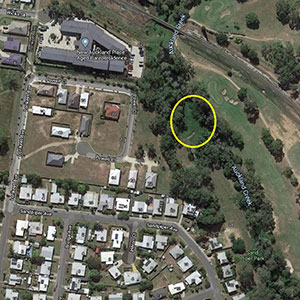Living Here
Team effort as Council conservation crew plant hundreds of native plants

An area once infested with invasive pest weeds and the occasional stray golf ball now has a new lease on life thanks to conservation work undertaken by Gladstone Regional Council.
A 1100m2 parcel of land running adjacent to Auckland Creek, near Sandpiper Avenue at New Auckland and located only a chip shot away from the 14th green of Gladstone Golf Club, is now home to more than 370 native plants.
 Densely infested with more than half a dozen species of weed, the weed removal process took a Council Conservation Field Officer and Conservation Trainee several days to complete.
Densely infested with more than half a dozen species of weed, the weed removal process took a Council Conservation Field Officer and Conservation Trainee several days to complete.
Prior to the planting of 377 native plants, Council had a contractor conduct minor earthworks and deliver and lay mulch on the site.
Following the laying of mulch, additional Council employees joined Gidarjil Development Corporation’s Skilling Queenslanders for Work students and volunteers from Gladstone Regional Council’s Friends of Conservation program for the planting event.
Gladstone Region Councillor Chris Cameron said the tree-planting exercise was originally due to coincide with National Tree Day on 2 August, but that event had to be cancelled due to the ongoing COVID-19 health emergency.
“Council employees had already started work on the site and had grown the plants for the event, so the desire to go ahead with the planting definitely remained,” Councillor Cameron said.
“The planting event took place on 27 July with the help of 12 participants and judging by the before and after photos of the site, it was time well spent.”
Cr Cameron, who sits on the management committee of Capricorn Pest Management Group alongside Deputy Mayor Kahn Goodluck, said the goal of the project was to clear a protected riparian corridor of weed, in order to prevent weed seed spreading through waterways.
“By clearing this area of several weed species, Council is significantly lowering the risk of weed seeds spreading downstream and popping up in other areas along Auckland Creek,” Cr Cameron said.
“Council will continue to rehabilitate the area over time, monitoring and controlling possible weed regrowth that may occur.
“The revegetation and mulching of the area will help native plants to thrive and outcompete the weeds, with the mulch also helping to stifle weed regrowth.
“The site will be monitored every month for the next three to six months, continuing indefinitely every six to 12 months as required.”
Some of the native plants planted at the site include:
- Barklya syringifolia (Crown of Gold – Gladstone’s floral emblem)
- Pleiogynium timorense (Burdekin Plum)
- Melia azedarach (White Cedar)
- Canavalia rosea (Beach Bean)
- Breynia oblongifolia (Coffee Bush)
- Cupaniopsis anacardioides (Tuckeroo)
- Jasminum simplicifolium (Native Jasmine)
- Acacia disparrima (Hickory Wattle)
- Micromelum minutum (Lime Berry)
- Eustrephus latifolius (Wombat Berry)
- Hoya australis subsp.australis (Native Hoya)
- Mallotus philippensis (Red Kamala)
- Carissa ovata (Currant Bush)
- Mallotus claoxyloides (Green Kamala)
- Harpullia pendula (Tulipwood)
- Lomandra longifolia (Spiky-headed mat rush)
- Acronychia laevis (Glossy Acronychia)
- Dianella caerulea (Blue Flax-lily)
- Elattostachys xylocarpa (White Tamarind)
- Elaeodendron melanocarpum (Black Olive Plum)
- Castanospermum austral (Black Bean)
- Synostemon albiflorus (Showy Sauropus)
- Trophis scandens (Burny Vine)
- Planchonia careya (Cocky Apple)
- Ficus racemose (Cluster Fig).
Please visit www.gladstone.qld.gov.au/environment for more information on the conservation programs and initiatives that are undertaken by Gladstone Regional Council.
See Also








